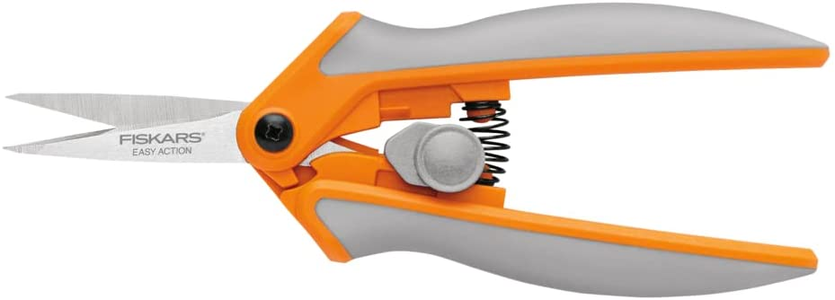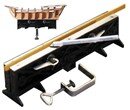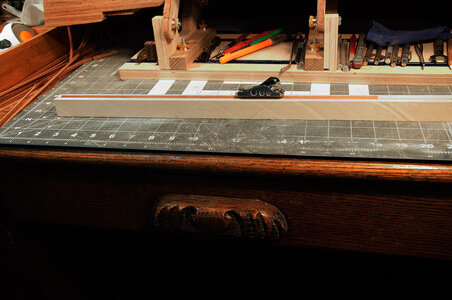-
LUCZORAMA SHIPWRECK SCAVENGER HUNT GIVEAWAY. 4 Weeks of Fun • 1 Legendary Prize ((OcCre’s Fram Ship)) • Global Crew Welcome!
**VIEW THREAD HERE**
You are using an out of date browser. It may not display this or other websites correctly.
You should upgrade or use an alternative browser.
You should upgrade or use an alternative browser.
Taper with a great straight-edge and a sharp knife. One note about 0.5mm strips, go real easy on the sanding.Does anyone have some suggestions on finish hull planking strips that are .5mm thick how to taper the planks?? especially you guys who built the La Soliel Royal looks like a pain?
Last edited:
- Joined
- Jan 21, 2022
- Messages
- 454
- Points
- 278

Thanks for the information was thinking about purchasing 1mm strips to replace the .05mm expensive!! will work with what I have!!Taper with a great straight-edge and a sharp knife. One note about 0.5mm strips, go real easy on the sanding.
I can cut or trim shorter 0.5mm strips using Fiskars scissors, the same ones I use for rigging. For long cuts along the grain, a brand new sharp razor knife with a straight rule is preferred, @Philski said.
Fiskars Scissors

Fiskars Scissors

Hi BandidoDoes anyone have some suggestions on finish hull planking strips that are .5mm thick how to taper the planks?? especially you guys who built the La Soliel Royal looks like a pain?
I did not really have an issue tapering the second planking
Using a sharp utility knife (Xacto) did the job
Going for 1mm planks may imply more work in terms of sanding
- Joined
- Dec 1, 2016
- Messages
- 5,950
- Points
- 728

Does anyone have some suggestions on finish hull planking strips that are .5mm thick how to taper the planks?? especially you guys who built the La Soliel Royal looks like a pain?
go here for a discussion on tapering planks
Planking question and examples
look at these pictures i was practicing having problems with the tapering thing I'm pretty sure I was supposed to taper a couple of planks I'm having a problem understanding which ones to taper and how I've been watching how to videos but I'm just getting frustrated nether pictures are that...
shipsofscale.com
Kurt, thanks for the tip! I just ordered the Fiskars Scissors! Magic Mike
Full size ship planks are tapered with a plane. At scale it is necessary to clamp each plank in a vice between two strips of harder wood or aluminum stock. You leave the stock to be removed exposed and simply (very carefully) plane flush. Doing this with a hand-held knife is a recipe for over-cutting and a wavy result. Scissors are not a good way to produce a jointed edge; they tend to cut a skew on anything thicker than paper. Small planes set very fine cut a perfect edge for jointing to the next plank and almost automatically produce a clean, smooth plank edge.Does anyone have some suggestions on finish hull planking strips that are .5mm thick how to taper the planks?? especially you guys who built the La Soliel Royal looks like a pain?
This would be a particularly hard thing to do on planks that are only 0.5mm thick. Planing works great on thicker planks though...and a jig can be made to support the stock. 1/2mm takes a sharp knife really easily (scalpel or X-Acto #11)Full size ship planks are tapered with a plane. At scale it is necessary to clamp each plank in a vice between two strips of harder wood or aluminum stock. You leave the stock to be removed exposed and simply (very carefully) plane flush. Doing this with a hand-held knife is a recipe for over-cutting and a wavy result. Scissors are not a good way to produce a jointed edge; they tend to cut a skew on anything thicker than paper. Small planes set very fine cut a perfect edge for jointing to the next plank and almost automatically produce a clean, smooth plank edge.
If you are cutting in the correct direction, trimming veneer strips with sharp scissors, then lightly sanding the edge to the final profile works just fine when the planks are already cut to short lengths. If you are trying to trim a strip that is over 20cm, then it can be difficult to handle.Full size ship planks are tapered with a plane. At scale it is necessary to clamp each plank in a vice between two strips of harder wood or aluminum stock. You leave the stock to be removed exposed and simply (very carefully) plane flush. Doing this with a hand-held knife is a recipe for over-cutting and a wavy result. Scissors are not a good way to produce a jointed edge; they tend to cut a skew on anything thicker than paper. Small planes set very fine cut a perfect edge for jointing to the next plank and almost automatically produce a clean, smooth plank edge.
I never had good results using a plane on thin veneer strips either, even when held firmly in a vice, even if the edge is just protruding above the edge of the jaws. It usually end up tearing the piece to splinters when the blade catches on an unexpected change in the grain direction, or the wood gets pulled upward after breaking friction with the jaws. Scissors and sanding seem faster and safer to me. Less waste.This would be a particularly hard thing to do on planks that are only 0.5mm thick. Planing works great on thicker planks though...and a jig can be made to support the stock. 1/2mm takes a sharp knife really easily (scalpel or X-Acto #11)
The rule here is that "If it works for you, then that is the correct way." Congrats for having a better hand than I do.This would be a particularly hard thing to do on planks that are only 0.5mm thick. Planing works great on thicker planks though...and a jig can be made to support the stock. 1/2mm takes a sharp knife really easily (scalpel or X-Acto #11)
Good advice on technique above. I have found that you need to clamp down .05 strips in order to cleanly trim them. There are different ways to do this so find a way that works for you. I use the STRIP CLAMP AND HULL HOLDER (MANTUA) as my tool for clamping down strips for trimming. A sharp no. 11 blade trims .05 strips clean…


- Joined
- Nov 28, 2020
- Messages
- 160
- Points
- 88

¿Alguien tiene algunas sugerencias sobre el acabado de las tiras de tablones del casco que tienen un grosor de .5 mm sobre cómo reducir los tablones? especialmente ustedes que construyeron La Soliel Royal parece un dolor? Acu
Thanks for the pic. This is exactly the sort of set-up that I tried to describe.Good advice on technique above. I have found that you need to clamp down .05 strips in order to cleanly trim them. There are different ways to do this so find a way that works for you. I use the STRIP CLAMP AND HULL HOLDER (MANTUA) as my tool for clamping down strips for trimming. A sharp no. 11 blade trims .05 strips clean…
View attachment 295698
If the grain tears then you are planing in the wrong direction. If the grain changes you are using the wrong piece of wood. You cannot plane wavy grain at scale. It is very difficult even with for 3/4" stock.I never had good results using a plane on thin veneer strips either, even when held firmly in a vice, even if the edge is just protruding above the edge of the jaws. It usually end up tearing the piece to splinters when the blade catches on an unexpected change in the grain direction, or the wood gets pulled upward after breaking friction with the jaws. Scissors and sanding seem faster and safer to me. Less waste.
Please do not use this knowledge to fashion scale models of conflict vessels. Please build models that represent joy and production, not fear and destruction. Please do not show war implements to children.
Last edited:
- Joined
- Jan 21, 2022
- Messages
- 454
- Points
- 278

that is how I also plane my planks but I would not think it will work for .5mmI've had great results planing thin planks (1mm, 2mm) using a jig and a small block plane. View attachment 295737
- Joined
- Jan 21, 2022
- Messages
- 454
- Points
- 278

Great discussion on planking I still feel uncomfortable using such thin planks not just because of the shaping of the planks but also the sanding .5mm could be unforgiving!! So I decided to purchase 1mm and give me some room to breathe and also upgrade the finish planking material Personal preference I guess!
Was getting a bit worried that my Endeavour hull planking was going to run out of strips, (2mm x 5mm x 30mm white timber as supplied with the kit).
Emailed Artesania Latina in Spain with such a request for more, and had a reply the SAME DAY, offering an extra bundle without charge if I could confirm
purchase with an invoice or docket. Sent this and again had confirmation that the goods would be sent, free, on the same day!! So nice to be treated so well by people the other side of the world!
Emailed Artesania Latina in Spain with such a request for more, and had a reply the SAME DAY, offering an extra bundle without charge if I could confirm
purchase with an invoice or docket. Sent this and again had confirmation that the goods would be sent, free, on the same day!! So nice to be treated so well by people the other side of the world!





